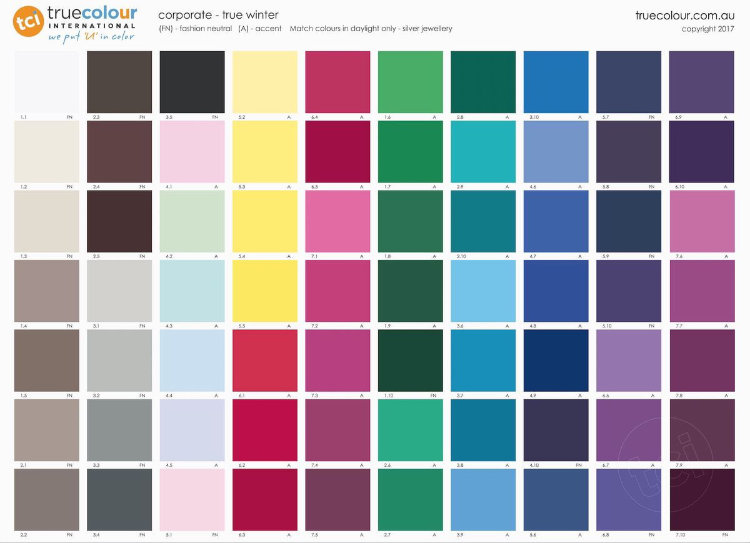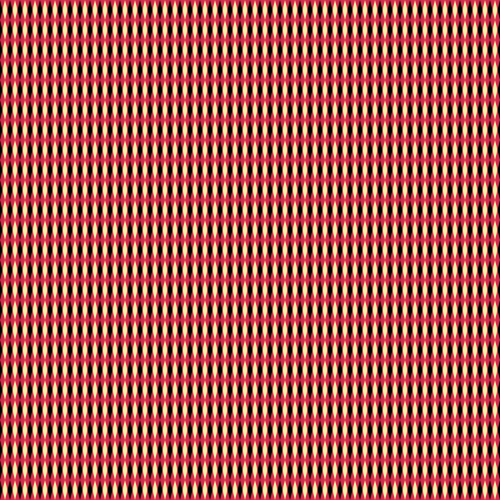True Winter: The Ultimate Guide
True Winter colours are cool, sharp, and vivid.
This is where you’ll find true white and true black, and all the colours that go with them — colours of blood, jewels, ice.
Our perception of colour harmony comes from the prehistoric natural world, the one our ancestors lived in while our visual colour systems were evolving.
So the question arises, where would they have seen true black and true white? They’re not common — compared to them, a magpie is off-white and a very dark brownish-grey, for example.
But the one that jumps to my mind, seen by all prehistoric humans, is the night sky. Especially on a moonless night, the sky would have been inky black (without city lights to reflect off the atmosphere), and stars, of course, bright white.
Other places to see True Winter colours are less universal — the closer to the poles we go, the more ice and snow we see, the colder, sharper and more contrasting the colours get.
So these colours have grandeur and distance; they're colours of a non-human scale.
Related: Images in 12 Tones
The palette
True Winter colours are sharp, cold, bright, powerful and crystalline. They completely lack ambiguity.
In our 12 tone chart, True Winter is the tone of complete coolness and clarity, which influences the two Bright tones (Bright Winter and Bright Spring) and the two Dark tones (Dark Winter and Dark Autumn). To all four, it contributes darkness, intensity and contrast.
So where do True Winter colours sit on the 3 dimensions of colour?
They are high in chroma (saturation).
The colours are cool, so they contain blue undertones, but no yellow undertones at all.
Finally, the colours range from lightest light (true white) to darkest dark (true black). Overall, the palette is medium-dark, because bright blue is medium-dark and these colours contain so much of that colour (see What Your Most Flattering Colours Have in Common for more on this).
Compared to True Summer, these colours are overall darker and brighter, but share temperature (cool).
Compared to Bright Winter, these colours are overall, cooler, slightly darker and not quite as bright.
Compared to Dark Winter these colours are overall brighter, cooler and slightly lighter.
True Winter colour dimensions
For more about Winter colours, see In Search of 12-Tone’s “Icy” Lights from Amelia Butler at True Colour International.
Clothing
If you’ve just discovered that you are a True Winter, and you’re learning how to create a True Winter wardrobe, congratulations! These are striking colours.
The good news is that, as a True Winter, true black is a staple for you.
Since black is so ubiquitous in the fashion world, you’re at something of a head start.
While an all-black outfit works, generally speaking you’ll do best adding some contrast to your outfits, because high contrast is a defining feature of Winter palettes.
Black and white is the classic True Winter combination, and will be truly striking on you.
High contrast combinations can also include colour, like these:
If you have a TCI True Winter fan, you’ll see some ideas about how to combine colours on the last arm of fan. (You can also see some on the classic palette image further up this page.)
You can combine your colours however you like — that’s the magic of knowing your colours — but they’re some ideas to get you started.
Putting it all together, here are Pinterest boards showing how a True Winter woman and man might create outfits.
Related: Women’s Fashion in 12 Tones
Related: Men’s Fashion in 12 Tones
For more inspiration, True Colour has a 12 Tone True Winter Pinterest Board showing wardrobe ideas for men and women, as well as a blog post of palette-matched Cashmere Pashminas for Winters.
Corporate Clothing
When I’m discussing corporate clothing here, I’m talking about more conservative workplaces — if yours is more casual, this may not be relevant for you.
That said, corporate clothing, in terms of colours, usually consists of some or all of these:
Neutral colours
Dark colours
High value contrast (light/dark)
True Winter is the easiest tone for a corporate wardrobe. Black or grey suits, white or icy shirts, done and done.
But many options from the True Winter palette will work, as long as you avoid mixing too many accent colours.
All the combinations shown earlier are good, except possibly the white and bright purple combination, which may need to be toned down with some black or grey. (Again, it depends on your particular workplace.)
Other suitable combinations are shown on the last arm of the TCI True Winter corporate fan.
And here are some more:
For more on corporate clothing, see Dark/True Winter Corporate Women from True Colour.
Patterns
Matching solid colours to your fan is one thing; matching patterns can be a trickier task.
If harmonising with the fan is too hard, try checking it against your face. If the colours are right, you’ll see the same effects you saw during your draping, like vitality, happiness, 3-dimensionality and authenticity.
What if most of the colours in a pattern are yours, but there’s one that clearly isn’t? Does it matter?
Again, I’d check it against your fan and your face, and see if there’s overall harmony, or if the different colour is too disruptive.
As an example, the first pattern below contains just True Winter colours. The second introduces small leaves of a Dark Autumn yellow-green, and the third spreads that yellow-green to cover the entire background.
The first is perfect. On the second, the small leaf is clearly disharmonious, but it’s so small that the overall impression is still similar to the first. But when the whole background turns yellow-green, the disharmonious effect is unavoidable. Pleasure, comfort, ease — all are gone.
A note of caution with patterns in brighter tones — medium to large prints often work better, depending on the colours involved.
Small elements of different colours can mix visually, softening the colours, and therefore reducing the harmony, as you can see in the patterns below.
These are all the same pattern, just at different sizes.
At some point the colours will start to mix together, so you no longer see the black, yellow and red as separate colours. Instead they create a warm red, which would fit into either the True or Dark Autumn tone much better than True Winter. The size at which the colours start to mix will depend on the size of your screen and your distance from it.
It’s easier to make sure that True Winter colours stay True Winter colours by choosing patterns on the medium to large scale.
Metals, jewellery, watches and glasses
The best metals for True Winter are silver and platinum. Because you require absolute coolness, gold is completely disharmonious with you and with your colours (except perhaps white gold).
Shiny metals usually fit better with your sharp, clear colours, as opposed to antiqued, matte or brushed metals.
Less shiny metals can work if the other elements of the item — stones in jewellery, band and face in a watch — are perfect.
Beautiful stones for True Winter jewellery are diamonds, rubies, emeralds, sapphires, jet, obsidian, and many colours of Swarovski crystals. Clear and sparkly is often better than opaque, and always better than anything earthy.
Glasses frames can be black or silver or, of course, any of the colours in the palette.
Hair colour
I’ve collected some hair colour options for True Winters in the Pinterest board below. Most are dark — True Winters usually only go light when they go grey, which looks perfect on them, and definitely better than yellowed-blonde.
Makeup
Complexion makeup (foundation, concealer, etc.) needs to be matched to your skin. If you have trouble finding or matching foundation, I have a blog post that might help.
The “colour makeup” comes from your True Winter palette.
True Winter icy colours and neutrals
Your whites, greys, black, taupes, and icy colours are your neutral eyeshadows. The greys and taupes are brow colours, grey and black eye liners, and mascara is black.
True Winter purples, blues and greens
Or, if bright makeup is your thing, any of the accent colours in your palette for eye looks can work, like a violet eye liner or sapphire eyeshadow.
True Winter reds and pinks
Blush and lip colours come from the red, pink and magenta area of your palette. All will work on you, but most women will find their perfect shade is somewhere within this range, so trial and error may be necessary here.
If you find the lip colours too strong for everyday wear, try:
a lighter colour in your palette — darkness adds drama;
a sheer formulation like a gloss, balm or sheer lipstick;
applying your lipstick over a clear lip balm, which will sheer it out;
applying your existing lipstick lightly, then blotting it away to create a stained lip; or
skipping lip colour altogether.
For more on your lip colours, see Embracing Winter Lips from Truth Is Beauty.
Similarly with blush, if you find the colour too strong, just apply less of it. I brush off blushes on the inside of my wrist before applying them to clients, so that there’s very little left on the brush. This gives a gentle barely-there colour that does the face-lifting and eye-brightening job of blush, without being obvious.
Cream blushes (or lipstick used as blush) can be a more natural looking option as well, because they’re less likely to sit on top of the skin, and less likely to build up in intensity too fast.
Avoid resorting to softer colours for lipstick and blush. They belong in another palette. While they may feel more approachable, they won’t harmonise with you, and may make you look fuzzy or indistinct.
Related: Makeup Looks in 12 Tones
The classic Winter makeup is the pin-up look, with light eyeshadow, winged black liner and a red lip.
But that’s far from your only choice. All the greys make smoky and dramatic eye looks easy.
Natural can seem harder, but just choose a sheerer lip as discussed above, add mascara, et voilà! Takes two minutes and looks effortless. Eyeshadow not required.
A note of caution — bronzer is a product used for adding warmth to the face. Remember how terrible you looked in warm drapes at your PCA? That’s what bronzer will do to you. Not everything is for everyone.
You’re not a bronze goddess. You are a stunning snow princess.
Weddings
If you’re getting married, congratulations!
Wearing your suit or dress and accessories (like a boutonnière or bouquet) in your colours will bring out your best on your wedding day. Incredibly easy for True Winter.
The classic black suit and white shirt will always look amazing, though you can opt for grey or icy colours if you prefer. You can stick to the neutrals for a tie and boutonnière, or bring in a brighter colour from your palette.
The whitest wedding dress you can find will be perfect, though it’s always a good idea to bring in some dark or bright contrast, in your shoes, bouquet and jewellery, or even a sash or other element on the dress itself. Or go new school, with a jewel-toned dress instead.
Or you can extend your colours to the whole event. True Winter colours make for a classic, dramatic, striking wedding, as you can see below.
Related: Wedding Inspiration in 12 Tones
Living spaces
True Winter colours are often used in modern interior designs, like you’d find in an apartment in a skyscraper.
They create clean, simple, dramatic rooms, as you can see in the Pinterest board below.
Related: Living Spaces in 12 Tones
Pin this:























